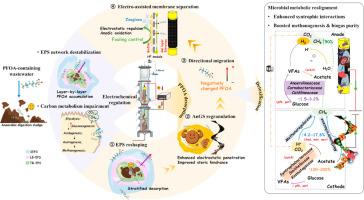缓解电化学辅助螺旋上流式厌氧膜反应器对全氟辛酸的抑制作用:EPS相互作用-解吸动力学和代谢途径重建
IF 12.4
1区 环境科学与生态学
Q1 ENGINEERING, ENVIRONMENTAL
引用次数: 0
摘要
全氟辛酸(PFOA)在工业废水中的广泛存在,由于其化学稳定性和持久性,对厌氧处理系统提出了重大挑战。本文通过Ru-Ir/ ti网包裹中空纤维膜阳极和螺旋ti网阴极的集成,开发了一种电化学螺旋上流式厌氧膜反应器(EC-SU-AnMBR),以促进PFOA的解吸解毒。在开路模式下,PFOA容易通过疏水相互作用和静电吸附积聚在紧密结合的细胞外聚合物(EPS)中,破坏厌氧颗粒污泥(AnGS)结构并损害微生物功能。电化学调控(闭路)有效缓解了PFOA的抑制作用,COD去除率为80.7% (vs. 66.7%), CH4回收率提高1.5倍(227.7 mL/g COD/d vs. 140.8 mL/g COD/d)。电场迁移和生物阳极-膜拦截/氧化共同通过改变EPS结构稳定性和相互作用-解吸动力学来削弱PFOA- angs的结合能力,将生物反应器中的PFOA保留率从最初的60.4%降低到2.1% (p < 0.01),并加强污泥的再颗粒化。进一步的分析表明,生物电催化通过选择性地在两个生物电极上富集水解/产酸细菌和共生产甲烷菌群(Smithellaceae, Kosmotogaceae和Methanotrichaceae),上调了参与葡萄糖代谢(pfk, por和ackA)和产甲烷(fwd, mtr和mcr)的功能基因的相对丰度。本研究提出了一种有前景的EC-SU-AnMBR系统,用于PFOA污染废水的可持续处理,并阐明了PFOA胁迫下宏基因组的代谢适应机制。本文章由计算机程序翻译,如有差异,请以英文原文为准。

Mitigating perfluorooctanoic acid inhibition in electrochemically-assisted spiral upflow anaerobic membrane reactor for wastewater treatment: EPS interaction-desorption dynamics and Metabolic pathway reconstruction
The widespread occurrence of perfluorooctanoic acid (PFOA) in industrial wastewater poses a major challenge to anaerobic treatment systems due to its chemical stability and persistence. Here, an electrochemical spiral upflow anaerobic membrane reactor (EC-SU-AnMBR) was developed by integrating a Ru-Ir/Ti-mesh-wrapped hollow-fiber membrane anode and a spiral Ti-mesh cathode to facilitate PFOA desorption and detoxification. PFOA readily accumulated in tightly bound extracellular polymeric substances (EPS) under open-circuit mode via hydrophobic interactions and electrostatic adsorption, disrupting anaerobic granular sludge (AnGS) structure and impairing microbial functionality. Electrochemical regulation (closed-circuit) effectively alleviated PFOA inhibition, achieving COD removal of 80.7% (vs. 66.7%) and a 1.5-fold higher CH4 recovery (227.7 vs. 140.8 mL/g COD/d). Electric field-migration and bioanode-membrane interception/oxidation together weakened PFOA-AnGS binding capability by altering EPS structural stability and interaction-desorption dynamics, decreasing PFOA retention rate in the bioreactor from initial 60.4% to 2.1% (p < 0.01) and reinforcing sludge regranulation. Further analysis demonstrated that the bioelectrocatalysis upregulated the relative abundance of functional genes involved in glucose metabolism (pfk, por, and ackA) and methanogenesis (fwd, mtr, and mcr) by selectively enriching hydrolytic/acidogenic bacteria and syntrophic-methanogenic consortia (Smithellaceae, Kosmotogaceae, and Methanotrichaceae) at both bioelectrodes. This study proposes a promising EC-SU-AnMBR system for the sustainable treatment of PFOA-contaminated wastewater and elucidates the metagenome-informed metabolic adaptation mechanisms under PFOA stress.
求助全文
通过发布文献求助,成功后即可免费获取论文全文。
去求助
来源期刊

Water Research
环境科学-工程:环境
CiteScore
20.80
自引率
9.40%
发文量
1307
审稿时长
38 days
期刊介绍:
Water Research, along with its open access companion journal Water Research X, serves as a platform for publishing original research papers covering various aspects of the science and technology related to the anthropogenic water cycle, water quality, and its management worldwide. The audience targeted by the journal comprises biologists, chemical engineers, chemists, civil engineers, environmental engineers, limnologists, and microbiologists. The scope of the journal include:
•Treatment processes for water and wastewaters (municipal, agricultural, industrial, and on-site treatment), including resource recovery and residuals management;
•Urban hydrology including sewer systems, stormwater management, and green infrastructure;
•Drinking water treatment and distribution;
•Potable and non-potable water reuse;
•Sanitation, public health, and risk assessment;
•Anaerobic digestion, solid and hazardous waste management, including source characterization and the effects and control of leachates and gaseous emissions;
•Contaminants (chemical, microbial, anthropogenic particles such as nanoparticles or microplastics) and related water quality sensing, monitoring, fate, and assessment;
•Anthropogenic impacts on inland, tidal, coastal and urban waters, focusing on surface and ground waters, and point and non-point sources of pollution;
•Environmental restoration, linked to surface water, groundwater and groundwater remediation;
•Analysis of the interfaces between sediments and water, and between water and atmosphere, focusing specifically on anthropogenic impacts;
•Mathematical modelling, systems analysis, machine learning, and beneficial use of big data related to the anthropogenic water cycle;
•Socio-economic, policy, and regulations studies.
 求助内容:
求助内容: 应助结果提醒方式:
应助结果提醒方式:


